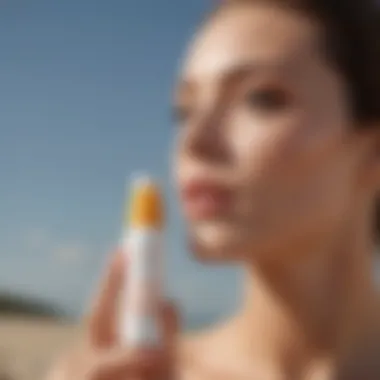Unlocking the Secrets: How to Choose the Healthiest Sunscreen for Radiant Skin


Fashion Trends
When it comes to choosing the healthiest sunscreen for your skin, fashion trends may not be the first thing that comes to mind. However, it is essential to consider how sunscreen fits into your overall skincare routine, especially during the warm-weather months when protecting your skin from harmful UV rays is paramount. Ensuring that your sunscreen not only provides adequate protection but also complements your daily fashion choices is key. From compact sizes for on-the-go touch-ups to elegant packaging that adds a touch of luxury to your vanity, the sunscreen you choose can seamlessly blend into your fashion-forward lifestyle. Sunscreens with innovative formulations that cater to specific skin concerns are also gaining traction in the beauty industry, allowing you to protect and pamper your skin simultaneously.
Beauty Tips and Tricks
In the realm of beauty, selecting the right sunscreen involves more than just SPF levels; it is about finding a product that harmonizes with your skincare regimen. Understanding the nuances between mineral and chemical sunscreens is crucial to tailoring your sun protection to your skin's unique needs. Mineral sunscreens, often formulated with zinc oxide or titanium dioxide, create a physical barrier on the skin, reflecting UV rays. On the other hand, chemical sunscreens absorb UV rays, converting them into heat before releasing them from the skin. Each type has its advantages and considerations, making it important to choose based on factors such as skin type, sensitivity, and desired wear. Incorporating sunscreen into your daily makeup routine poses its own set of challenges, from potential white cast with mineral sunscreens to layering concerns with certain makeup products. Experimenting with different application techniques, such as mixing sunscreen with foundation or opting for tinted sunscreens, can help achieve a seamless makeup look while safeguarding your skin.
Celebrity Buzz
Celebrities play a significant role in setting beauty trends and inspiring skincare habits, making their sunscreen choices particularly noteworthy. Red carpet events often showcase celebrities flaunting healthy, glowing skin, attributing their radiance to diligent sunscreen application. Beauty enthusiasts can take cues from celebrity-approved sunscreens that offer both protection and skin-enhancing benefits. As the fashion police dissect celebrity looks, sunscreen becomes a staple accessory, proving that sun protection can be chic and trendy. Celebrity style spotlights frequently highlight not only fashionable attire but also skincare routines that prioritize sun protection. By emulating celebrity practices and preferences, individuals can discover new sunscreen brands and formulations that align with their skin goals and lifestyle.
Trend Reports
Tracking evolving sunscreen trends is essential for staying informed about the latest advancements in sun protection. Street style snapshots capture how individuals integrate sunscreen into their daily lives, whether through innovative application methods or trendy packaging that appeals to the fashion-conscious. Beauty product reviews offer valuable insights into the efficacy and user experience of popular sunscreens, guiding consumers in making informed purchasing decisions. Fashion forecast analysis predicts upcoming trends in sun care, from lightweight formulations suitable for humid climates to eco-friendly options that align with sustainable beauty practices. By staying abreast of trend reports, individuals can navigate the vast landscape of sunscreen products with confidence, selecting options that prioritize both skin health and style preferences.
Introduction
In the journey towards selecting the healthiest sunscreen for your skin, the notion of sun protection emerges as a fundamental aspect. Understanding the significance of sunscreen goes beyond mere cosmetic applications; it delves into the realm of skin health preservation against the detrimental effects of UV radiation.
Importance of Sunscreen
UV Radiation and Skin Damage
UV radiation stands as a relentless force, capable of inflicting significant damage to the skin. Its ability to penetrate the epidermis, triggering DNA mutations and premature aging, underscores the critical role of sunscreen in mitigating these effects. By forming a protective barrier, sunscreens shield the skin from harmful UVA and UVB rays, reducing the risk of sunburns, skin cancer, and photoaging.
Role of Sunscreen in Skin Protection


The pivotal role of sunscreen lies in its ability to act as a defense mechanism against the adverse impacts of UV exposure. By creating a barrier on the skin's surface, sunscreen intercepts and neutralizes UV rays, preventing them from causing lasting harm. This protective function not only minimizes immediate damage but also contributes to the long-term health and vitality of the skin.
Types of Sunscreens
Chemical Sunscreens
Chemical sunscreens function by absorbing UV radiation and converting it into heat, which is then released from the skin. Their lightweight formulations make them popular for daily wear, offering ease of application and comfortable wearability. However, the potential for skin irritation in some individuals and the necessity for reapplication after sweating or swimming are notable considerations with chemical sunscreens.
Mineral Sunscreens
In contrast, mineral sunscreens, formulated with active ingredients like zinc oxide and titanium dioxide, create a physical barrier that reflects and scatters UV rays away from the skin. Their natural ingredients make them ideal for sensitive skin types, with the added benefit of being gentle yet effective in sun protection. While mineral sunscreens may leave a slight white cast on the skin, their non-comedogenic properties make them a safe choice for those prone to breakouts.
Physical vs. Chemical Protection
The debate between physical and chemical protection hinges on individual preferences and skin sensitivities. Physical sunscreens, comprising mineral ingredients, offer broad-spectrum protection and tend to be more stable when exposed to sunlight. On the other hand, chemical sunscreens provide a cosmetically elegant option, blending seamlessly into the skin without leaving a visible residue. Understanding the nuances of these two types can guide users in selecting the most suitable sunscreen for their specific needs.
Understanding SPF
SPF Ratings Explained
SPF, or Sun Protection Factor, serves as a metric for measuring a sunscreen's efficacy in blocking UVB rays. The numerical value assigned to an SPF indicates the level of protection it offers against sunburn. Higher SPF ratings denote increased protection, although experts recommend a minimum of SPF 30 for adequate coverage. It's essential to note that SPF only pertains to UVB rays, emphasizing the need for broad-spectrum sunscreens to safeguard the skin against UVA rays as well.
Effectiveness and Reapplication
The effectiveness of sunscreen hinges on proper application and timely reapplication. To maintain optimal protection throughout the day, users should apply a generous amount of sunscreen at least 15 minutes before sun exposure. Reapplication every two hours or immediately after swimming or sweating ensures continuous shielding against UV radiation. By adhering to these practices, individuals can maximize the benefits of sunscreen and fortify their skin's defense against sun-induced damage.
Choosing the Healthiest Sunscreen


Ingredients to Avoid
Oxybenzone
Oxybenzone, a common ingredient found in many sunscreens, is known for its ability to absorb and dissipate UV radiation. While Oxybenzone effectively protects the skin from sun damage, some studies suggest potential adverse effects on marine life and coral reefs due to its chemical composition. Its popularity stems from its high efficacy in blocking UV rays, making it a preferred choice for individuals seeking strong protection against sun exposure.
Octinoxate
Octinoxate is another active ingredient in sunscreens that assists in UV absorption. The key characteristic of Octinoxate lies in its ability to provide broad-spectrum protection, safeguarding the skin from both UVA and UVB rays. Despite being a popular choice for sunscreens, concerns have been raised regarding its environmental impact, prompting some users to seek alternative options for sun protection.
Retinyl Palmitate
Retinyl Palmitate, a derivative of Vitamin A, offers additional skin benefits by supporting skin cell turnover and regeneration. While it contributes positively to skincare, some debate surrounds its potential link to skin sensitivity and irritation in certain individuals. The inclusion of Retinyl Palmitate in sunscreens can provide anti-aging benefits, making it a sought-after ingredient for those looking to address aging skin concerns.
Key Features of Healthy Sunscreens
Broad-Spectrum Protection
Broad-spectrum protection is a crucial feature to look for in sunscreens as it ensures comprehensive defense against both UVA and UVB rays. Choosing a sunscreen with broad-spectrum coverage guarantees that your skin is shielded from a wide range of harmful sun rays, reducing the risk of sunburn, premature aging, and skin cancer. This feature is essential for individuals focusing on long-term skin health and sun protection.
Water Resistance
Water resistance is a beneficial characteristic in sunscreens, especially for those engaging in water activities or outdoor sports. Sunscreens labeled as water-resistant offer extended protection, maintaining their efficacy even after exposure to water. This feature is ideal for individuals who sweat profusely or spend time in humid conditions, ensuring continuous protection against sun damage.
Non-Comedogenic Formulas
Non-comedogenic formulas are designed to prevent pore clogging, making them suitable for individuals with acne-prone or sensitive skin. These formulas are oil-free and do not block pores, reducing the risk of breakouts and skin irritation. Choosing a non-comedogenic sunscreen ensures that your skin remains clear and healthy while receiving essential sun protection benefits.


Stay tuned for the following sections as we explore more facets of selecting the healthiest sunscreen for your skin, emphasizing key considerations and recommendations to guide your skincare choices.
Application and Maintenance
In the journey towards choosing the healthiest sunscreen for your skin, the Application and Maintenance of the sunscreen plays a crucial role. Proper application techniques and timely maintenance ensure optimal protection from the sun's harmful rays. By adhering to recommended application methods and schedules, you enhance the efficacy of the sunscreen, safeguarding your skin effectively.
Proper Application Techniques
Amount of Sunscreen to Use
When it comes to the Amount of Sunscreen to Use, precision is key. Applying an adequate amount ensures that your skin receives the intended level of protection against UV radiation. The recommended quantity typically ranges from a nickel-sized amount for the face to a palmful for the body. This ensures even coverage and maximum efficacy of the sunscreen, making it a popular choice among skincare enthusiasts.
Application Frequency
The Application Frequency of sunscreen is equally essential in maintaining its effectiveness. Reapplication is recommended every two hours or more frequently if you're sweating or swimming. This frequent reapplication ensures continuous protection throughout the day, especially during prolonged sun exposure. Consistent reapplication is a beneficial practice that minimizes the risk of sun damage, making it a preferred strategy for effective sun protection.
Storage and Expiry
Proper Storage and awareness of Expiry dates are vital aspects of maintaining sunscreen quality. Understanding the Shelf Life of Sunscreen helps in ensuring that you use the product within its most effective period. Most sunscreens have a shelf life of about 2-3 years, but this can vary based on the formulation. Adhering to Storage Conditions such as keeping the product away from direct sunlight and high temperatures prolongs its effectiveness. Proper storage not only maintains the sunscreen's quality but also maximizes its benefits, making it a prudent choice for comprehensive skin protection.
Conclusion
In concluding the discussion on selecting the healthiest sunscreen for your skin, it is essential to emphasize the critical role that conscious decision-making plays in maintaining optimal skin health. By prioritizing the protection and well-being of your skin, you are not only safeguarding against immediate sun damage but also mitigating long-term risks of skin cancers and premature aging. This article serves as a comprehensive guide to empower individuals in making informed choices when it comes to sun protection.
Final Thoughts on Sunscreen Selection
Prioritizing Skin Health
Prioritizing skin health stands as a cornerstone in the realm of sunscreen selection. Through this approach, individuals exhibit a commitment to nurturing and preserving the skin's integrity amidst varying environmental stressors. The key characteristic of prioritizing skin health lies in its proactive nature, aiming to prevent rather than solely treating sun-induced skin issues. Embracing prioritizing skin health as a core principle in sunscreen selection resonates with those seeking a holistic approach to skincare, incorporating preventive measures into their daily routine.
Informed Sun Protection Choices
Making informed sun protection choices complements the overarching goal of this article, as it empowers individuals with the knowledge needed to select sunscreens tailored to their specific needs. The unique feature of informed sun protection choices lies in the personalized approach it affords, ensuring that individuals can cater to their skin requirements effectively. Understanding factors such as SPF levels, ingredients to avoid, and application techniques equips individuals to make conscious decisions that align with their skin health objectives. While the advantages of informed sun protection choices are evident in promoting skin well-being, it also cultivates a sense of accountability in individuals, fostering a deeper connection to their skincare routines.















